| Reviews & Columns |
|
Reviews DVD TV on DVD Blu-ray 4K UHD International DVDs In Theaters Reviews by Studio Video Games Features Collector Series DVDs Easter Egg Database Interviews DVD Talk Radio Feature Articles Columns Anime Talk DVD Savant Horror DVDs The M.O.D. Squad Art House HD Talk Silent DVD
|
DVD Talk Forum |
|
|
| Resources |
|
DVD Price Search Customer Service #'s RCE Info Links |
|
Columns
|
|
|
Jean Renoir Collector's Edition
THE MOVIES:
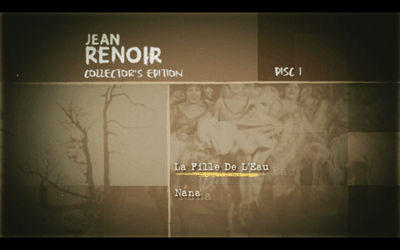
Jean Renoir has had a long and varied career in cinema, and he is often cited as the most influential international director, perhaps only comparable to Orson Welles (who cited the French cineaste as an inspiration). The son of the Impressionist painter Pierre Auguste Renoir, Jean helmed 41 films in a career that spanned seven decades. Thus, even though it houses seven of his movies, the 3-disc Jean Renoir Collector's Edition is merely a taste of what the pioneer's filmography has to offer.
There is no overriding theme to the films chosen for this set, but the featured movies do show both ends of the master's career. The first half of the selections come from the 1920s and represent the silent era, while the other three films represent various stages of his sound career, including two from the late 1950s and early 1960s. All seven were made in France, skipping over his period as a Hollywood director. Even so, taken together, the Jean Renoir Collector's Edition represents the gamut of the social dramas and theatrical humor that define the Renoir style, as well as showing his evolving facility with mise-en-scene. They aren't all equal in quality, but they all at least have something interesting about them to recommend them.
***DISC 1 ***
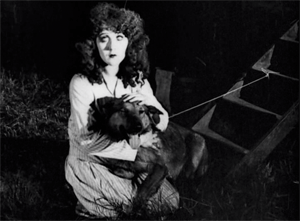
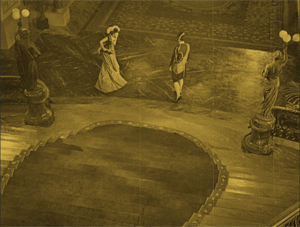
left to right: Whirlpool of Fate; Nana
* Whirlpool of Fate (La Fille de L'Eau) (silent; 72 minutes - 1925): This overwrought melodrama is Renoir's second film, and his first as a solo director. Working from a script by Pierre Lestringuez, a frequent collaborator in this silent period, Renoir tells the story of Virginia (Catherine Hessling, Renoir's wife from 1920 to 1930), a hard-luck case who can't catch a break. First her father dies and her uncle (Lestringuez) tries to rape her, then she hooks up with poachers and gypsies, only to be persecuted by the local bully and driven mad in the woods. Through it all, the local rich boy (Harold Levingston) keeps his eye on Virginia, and it's quite clear to Renoir's camera that he is developing a thing for the urchin. Naturally, he waits in the wings to pull her out of the whirlpool that threatens to drag her down.
There are far more complex plots than this one. In some ways, The Whirlpool of Fate comes off as if it were written for a cliffhanger serial. Every couple of scenes, Virginia's life takes another turn, and her very existence is put in peril over and over. As a mild diversion, there is a kind of goofy charm to the movie, but it shows the great director only taking tentative steps into the cinematic arena. He doesn't yet know how to draw great performances out of his actors, and pacing is a definite issue for the young filmmaker. There are several scenes that go on too long, which we particularly notice when we see it takes an inordinate amount of time for people just out of frame to react. Even so, early hints of what was to come are here. Renoir's often slapstick sense of humor pops up from time to time, and he's already showing a flair for it. There are also some fairly ambitious dream sequences that prefigure the surrealist movement's experiments in cinema years later (including some sideways imagery that reminded me of Cocteau's Blood of a Poet), as well as an incredibly ambitious use of quick cutting in the scene where Virginia is attacked by her uncle. Jumping swiftly from the brutal fight to a barking dog and then to a ringing alarm clock not only amps up the frenzied feeling, but it even evokes sense memories of sound.
Picture/Sound: The film begins with an explanation of the efforts Studio Canal took to restore Whirlpool of Fate, including having to rebuild the French title cards by translating English titles back into the film's original language. In some scenes, the restoration job is breathtakingly pristine, while others look like they were dragged behind the back of a truck. Given the great disparity between them, it would lead me to believe the best was done with the elements available. The title cards, which are often quite wordy, are subtitled in English very well, moving at an easy-to-read speed. The only misstep here is when the white text of the translation is sometimes superimposed over the top of the French, and the two sets of white lettering gets slightly jumbled. Marc Perrone composed the score to accompany the movie, and in what sounds like a contemporary recording, it's played almost exclusively on an accordion, including some sounds that mimic onscreen action. Using the click of the instrument's keys to represent rapid footsteps is a particularly nice touch. The movie is full frame.
* Nana (silent; 130 min. - 1926): Once again working with Lestringuez, Renoir adapts the Emile Zola novel, casting his Whirlpool starlet, Catherine Hessling, in the title role--and oh, what a difference a year makes! Renoir took to this grand costume epic much easier than he did any of the pre-sound shorts in this collection. Nana is a terrible stage actress whose sexual allure draws in several society men. Wrapping them around her finger, she convinces one to bribe her into a starring role in the theatre and another to ruin his good name betting against his own racehorse in favor of one named after the starlet. Eventually, though, the acting thing is going to meet its inevitable doom, and Nana ends up becoming a courtesan, seeing gentlemen callers in her opulent mansion. With so many men obsessed with her and competing for her affections, it's only going to lead to trouble, and eventually, Nana's wicked ways catch up with her.
Hessling is way over the top in her performance, even by silent-era standards. Yet, there is such a consistency to her demonstrative acting that she actually pulls it off. Nana is a larger-than-life character, and so Hessling's exaggerated gestures and wide-eyed expressions seem like the right notes to hit (even if Hessling is ironically being a bad actress in her portrayal of a bad actress). In comparison to the overly staid performances from the actors filling the roles of the upper classes, these choices make sense. Nana's sexual appeal is her wildness. It's what makes her different than the uptight bourgeoisie.
For Renoir's part, the future director of The Rules of the Game is already interested in the hypocrisy and hidden secrets of the rich. He uses massive set pieces to show the ridiculous opulence enjoyed by the well-to-do in French society. They have more space than they can ever possibly fill, and their tiny lives look even smaller within it. He also takes a certain impish glee in exposing their bedroom activities, paying particular attention to a Count (Werner Kraus) who goes in for a little domination. Decked out in his full military regalia, he gets down on all fours and barks like a dog, all for Nana's pleasure. For all the public shame these characters will experience in the final act, it compares little to their private shame.
Picture/Sound: The full frame picture has been scrubbed up and polished fantastically well. Though the occasional scratch, crackle, and pop still shows, 90% of the picture looks marvelous. The film is tinted in various colors, and I don't know if it is intentional, but the way the section colors are ordered reflects the rise and fall of Nana. The early scenes burn hot with a yellowish fire, while the final scenes are in a dark blue.
Nana was originally restored in 2002, and March-Olivier Dupin created new music for it. That recording is used here.
***DISC 2 ***
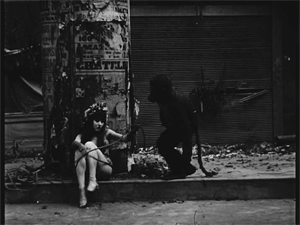
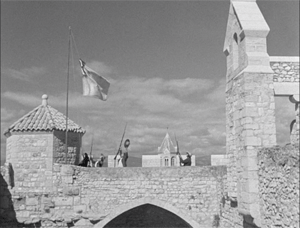
Charleston Parade; La Marseillaise
* Charleston Parade (Sur un Air de Charleston) (silent; 20 min. - 1927): A strange sci-fi short adapted by Lestringuez from a story by Andre Cerf. In 2028, Paris is an apocalyptic wasteland. The Eiffel Tower even has a bend in it. Traveling in a flying orb, an explorer from Africa (Johnny Huggins) comes to the city and meets a beautiful native girl (Hessling) and her monkey (someone in a monkey suit). Inexplicably, she spends most of the movie teaching him the Charleston. It's also strange that Huggins, a black performer, would appear in minstrel make-up, dressed in a tuxedo and top hat and smearing white paint around his lips. I suppose that Renoir was trying to make an ironic commentary about who the "savages" really were, subverting racial prejudice in entertainment and linking contemporary dance to clichés of tribal performance. I have no idea if it was effective in its day and age, but now it's just odd.
Watch for Renoir himself as one of the chorus of angels.
Picture/Sound: A pretty decent restoration. Though there is a fair amount of spots and dirt on the image, the underlying picture is sharp. There is no sound whatsoever, though, not even musical accompaniment--which just doesn't work for a movie that is 2/3 dancing. I listened to Thom Yorke on my iPod when I watched Charleston Parade, and it actually clicked pretty well.
* The Little Match Girl (La Petite Marchande D'Allumettes) (silent; 33 min. - 1928): This slight adaptation of the Hans Christian Andersen story stars Hessling as the titular heroine and is really only interesting for the early special effects efforts. Renoir uses models, rear projection, double-exposure, and fake backdrops to portray the fantasy journey of the Little Match Girl during her night out in the cold. Though some of the effects may look quaint to our modern eye, it's still impressive when you put it in its historical context and has a cool, expressionistic quality. The movie overall is a bit of a snooze, however, with the performances and the editing being a bit too laconic.
Picture/Sound: The film print for The Little Match Girl is in pretty poor shape. Persistent scratches and dirt are on every frame, though the image still has decent resolution. The musical score, which contains references to Wagner and other well-known compositions, is also rather tinny.
* La Marseillaise (132 min. - 1938): In the first sound picture on the Jean Renoir Collector's Edition, the maestro does his part to inspire patriotic fervor and maybe goes a little too far over to the propaganda side. This historical epic set during the French revolution follows a battalion of citizen soldiers--painters, masons, and other working-class warriors--as they gather together to stop aristocratic rule and take down Louis XVI (Pierre Renoir) and his foreign-born queen, Marie Antoinette (Lise Delamare). They march from Marseille to Paris. Along the way, a humble hymn gathers steam to become the anthem of the forces of revolt, and "La Marseillaise" becomes a phenomenon.
The script by Renoir, Carl Koch, and N. Martel Dreyfuss often feels more like a string of anecdotes than a wartime narrative. The movie strikes an odd tone, dramatizing the French Revolution as the most polite of wars. Rather than duke it out, combatants stop to discuss philosophy and politics--quite literally. When Honoré Arnaud (the singly named Andrex) leads his ragtag bunch in the takeover of a state fortress, the presiding commander, Saint-Laurent (Aimé Clariond), shrugs and asks his rival what's it all about. Arnaud explains the common man's cause to the rich man before sending him on his way, taking him at his word that he'll leave the country and the battle to the righteous. When there is fighting, it all takes place elsewhere, and we only hear about it later. You get the sense that this whole thing could have been settled over a good glass of wine if the right folks could have just sat down and talked it over. It's a revolution where cross words hurt worse than crossed blades. When a swordfight does break out in Paris, the sky immediately opens up and a sudden rainstorm sends the brawlers scurrying for shelter. Even Mother Nature wags her finger at the prospect of violence when there are more speeches about brotherhood to be made and complex dissertations on the new power structure.
Paradoxically, for all the history lessons, I often found myself lost, not knowing who certain historical figures were or what faction was fighting for what rights. I suppose attention to such reality may not be important in a story so broadly drawn. The revolutionaries are all genial, caring men who'd rather stop in on a puppet show than fight, while the rulers are clueless gadabouts who are more concerned with remembering their dance steps than the needs of the people. La Marseillaise definitely has a satirical bend, but it doesn't go very deep. Renoir nearly suckerpunches himself with this approach. When the unavoidable is finally encountered in the last fifteen minutes of the picture, his band of merry men look like they've been caught in a joke that's gone too far. Though the people do rally, and it's likely Renoir wanted to show from what humble beginnings great things spring, the brutality of the insurrection is off-kilter with the comic journey that got us there. The end result leaves one feeling a little nauseous and confused rather than fired up.
Picture/Sound: A spotty restoration job flits between scenes of absolute clarity and others that are more beat-up. Not grand, not horrible--more like something you'd have seen on cable ten or fifteen years ago. The audio is pretty good for a mono mix, and the subtitles read well, if maybe a little contemporary at times. One of the proletariat shouts "No way!" in response to a piece of news, and I was half expecting the messenger to reply with "Way!"
***DISC 3 ***
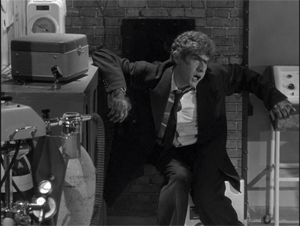
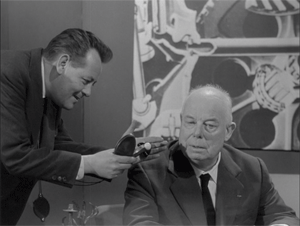
The Doctor's Horrible Experiment; Jean Renoir hosting that film
* The Doctor's Horrible Experiment (Le Testament du Docteur Cordelier) (97 min. - 1959): A gentle spoof of B-grade horror movies, The Doctor's Horrible Experiment brings the Jekyll & Hyde story all the way into the era of Freud. An aloof and pious psychiatrist, Dr. Cordelier (Jean-Louise Barrault), seems to be housing a dangerous criminal in his clinic, the twitchy pervert Mr. Opale. This creep wanders the streets in a suit that's a couple of sizes too big, wielding a walking stick and terrorizing young girls. Mayhem seems to be his only design, kicking the crap out of old men and cripples and groping hapless maidens. Of course, knowing the premise of the movie, we know well ahead of everyone else that Cordelier and Opale are one and the same, but part of the fun is being smarter than the smug cops and the witless colleagues of Cordelier who are trying to disentangle him from Opale's clutches. His lawyer, Joly (Teddy Bilis), nearly has less spine than brains, and the good doctor's rival, Séverin (Michel Vitold), is a hilarious parody of loudmouth intellectuals with delusions of grandeur.
The film really belongs to Barrault, however. The Children of Paradise star goes to town as the reprobate Opale. He struts around with loose limbs, like Chaplin on a bender. His Hyde is a European ancestor to Jerry Lewis' Nutty Professor (shall we call him Copain Amour?), more sleazy and funny than he is scary. Renoir is poking several sets of ribs here, including horror films and mental health institutions, and he is having a hoot doing it. He populates his sets with all kind of subversive materials, letting the details quietly speak for themselves. Opale's bordello getaway is full of whips and various fetish objects, whereas Cordelier's experiments are conducted with made-up contraptions. Funniest of all is when Joly goes searching through the doctor's closets looking for something to restrain the man's out-of-control Id. Each open door reveals something even more ludicrous than the last, including what I think is a full-size mannequin in a clown outfit. Renoir himself hosts the picture, introducing it at a TV studio as if it were a deadly serious morality play, but when the film closes, the director asks us if Cordelier is not the luckiest of all. Though the price of admission is ultimately grave, he got to experience a life without limits. Is the death of Opale also Renoir's requiem for the soon-to-pass neo-Victorianism of the 1950s?
Picture/Sound: The picture for The Doctor's Horrible Experiment is remarkably clean. There is no surface noise whatsoever, though every once in a while you might note a soft edge or some background lines that look a little like falling rain reflected on your screen. You have to look close for these errors, however, so sit back and enjoy and don't worry about it. The sound is also pretty decent, and the subtitles lively.
* The Elusive Corporal (Le Caporal Épinglé) (99 min. - 1949): One of Jean Renoir's most famous films is Grand Illusion, the story of French soldiers escaping from a WWI German POW camp. In 1962, he returned to that ground but advanced the World War by one, and by doing so, made the best movie in this set. The Elusive Corporal follows a group of captured French army men after Germany has occupied their homeland. They had been defending Poland, but now they are put to work on German land. One solider, known only as the Corporal (Jean-Pierre Cassel, The Discreet Charm of the Bourgeoisie), isn't willing to just sit back and let the Nazis tell him what to do, and the picture follows his numerous attempts to escape from the camps.
As in La Marseillaise, Renoir is most interested in the men who comprise an army, the regular folks who have been plucked from their regular lives to fight a war. They spend most of the time in the barracks discussing their old jobs--farmer, waiter, electrician, subway ticket taker, etc. Unlike La Marseillaise, however, Renoir finds the sweet spot between comedy and tragedy here. The Corporal's various schemes are amusing, though they never get as outrageous as similar American films like Stalag 17 or the television show Hogan's Heroes. The beauty of his escape plans is their simplicity. Watching a group of workers taking land measurements and going beyond the gates, for instance, inspires the Corporal to pick up a measuring tape and follow. If he gets lulled into a false sense of security, enjoying the comedy too much and forgetting that there is a war going on, there is always something to remind him of the stakes, such as the words of an admiring German girl (Conny Froboess) or the crack-up of a fellow inmate (Claude Rich). Renoir doesn't forget that France was under a real threat, and the country's need to get out from under German rule was as serious as the Corporal's need to get back there. Thus, when he is making a serious go of a particular flight, it is appropriately tense. Sometimes nail-bitingly so.
Another thing The Elusive Corporal has in common with La Marseillaise is a sense of camaraderie amongst the fighters. Brotherhood is important in such conditions, and most of the men act on each other's behalf without question. Some of them slide into a whole new way of life, but the Corporal is always moving, always reminding his comrades that they can't sit still. His strongest friendship is with Pop (Claude Brasseur, Band of Outsiders), and their bond illustrates how a common threat breaks social lines. In real life, they'd have been on different sides of the economic divide; in war, they are equal.
The Elusive Corporal is a fun, classy movie that entertains while Renoir sews a subtle meaning into the action. It's the kind of movie that earned him his reputation, and a fine way to close the Jean Renoir Collector's Edition.
Picture/Sound: The only film to be presented in widescreen (16X9) in the Jean Renoir Collector's Edition, The Elusive Corporal also gets the best transfer. It's consistently pristine, very nicely done. It does appear to be picture boxed, however, meaning that there are black bars on all four sides of the picture on a widescreen TV (see screencap at the bottom of the review; that's exactly how it looks on my widescreen laptop). This may not be to some people's liking, as it skews towards correcting for regular square television sets. Your mileage may vary.
The audio is also mixed very well, with nice use of background effects to give the movie a rich soundscape.
***
In summation, this collection of seven Jean Renoir films is a bit of a varied selection. Of the three DVDs, the third is the most essential, while the second would probably only warrant a rental on its own. Still, it's neat to see the breadth of a master filmmaker, going from clumsy neophyte all the way to accomplished journeyman. Jean Renoir Collector's Edition may not be representative of the director's best and brightest, but it still has moments of shining brilliance and should please any fan of the man's work.
THE DVD
Video/Sound:
Six of the movies included in the Jean Renoir Collector's Edition are full screen (4X3); the seventh, The Elusive Corporal, is widescreen (16X9). Please see descriptions of each disc's technical aspects in the individual reviews above.
Extras:
Disc 3 in the collection has a 33-minute documentary called "Jean Renoir: An Auteur to Remember." It is broken down in sections to cover each film individually, as well as pieces with more general information about Jean Renoir. Hosted by Martin Scorsese, it also features interviews with Ken Wlaschin of the American Film Insitute, Janet Bergstrom of the UCLA film department, and Alain Renoir, son of Jean Renoir and actress Catherine Hessling. (The DVD sleeve advertises that the documentary is supposed to also have Scorsese's frequent cinematographer, Michael Ballhaus, but if he's in there, I blinked and missed him. He's not thanked in the end credits, either.) It was made exclusively for this set, and though the time spent on each film is short, the featurette gets to the point. I felt I walked away with a much more informed understanding of why Renoir made each film and the technical/artistic challenges he gave himself. Scorsese disagrees with me about La Marseillaise, so I may have to rethink my position.
The three-DVD set comes in a double-width plastic case with a hinged disc holder on the inside. There is also an outer cardboard casing in the shape of a movie production clapboard. The clapper lifts up for the plastic case to be removed. The design is really swell, but my eagle-eyed editor pointed out that the font used on the packaging matches the font normally used by the Criterion Collection. Gilt by association?
FINAL THOUGHTS:
Recommended. Okay, so the Jean Renoir Collector's Edition isn't seven for seven, but there are really no out-and-out misses on this three-disc set. Of the four silent films, only Nana is one that invites multiple viewings, but all of them show the innovation of a young filmmaker learning his craft, and even though the talkie La Marseillaise is a bit all over the place, one can appreciate how Renoir conducts his actors. That leaves the final two, The Doctor's Horrible Experiment and The Elusive Corporal, a send-up of a B-grade horror and a fresh look at the POW-camp genre. Both are excellent and represent the sort of high art we should expect from Jean Renoir. For them alone, you want to grab this boxed set.
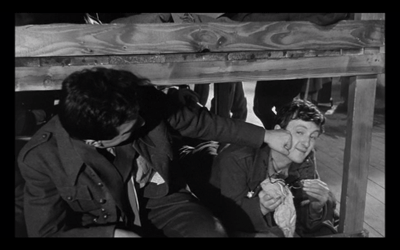
The Elusive Corporal
Jamie S. Rich is a novelist and comic book writer. He is best known for his collaborations with Joelle Jones, including the hardboiled crime comic book You Have Killed Me, the challenging romance 12 Reasons Why I Love Her, and the 2007 prose novel Have You Seen the Horizon Lately?, for which Jones did the cover. All three were published by Oni Press. His most recent projects include the futuristic romance A Boy and a Girl with Natalie Nourigat; Archer Coe and the Thousand Natural Shocks, a loopy crime tale drawn by Dan Christensen; and the horror miniseries Madame Frankenstein, a collaboration with Megan Levens. Follow Rich's blog at Confessions123.com.
|
| Popular Reviews |
| Sponsored Links |
|
|
| Sponsored Links |
|
|
| Release List | Reviews | Shop | Newsletter | Forum | DVD Giveaways | Blu-Ray | Advertise |
|
Copyright 2024 DVDTalk.com All Rights Reserved. Legal Info, Privacy Policy, Terms of Use,
Manage Preferences,
Your Privacy Choices | |||||||













